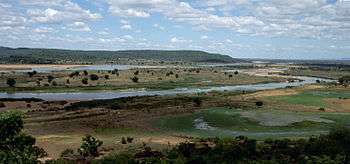Benue River


The Benue River (French: la Bénoué), previously known as the Chadda River or Tchadda, is the major tributary of the Niger River. The river is approximately 1,400 kilometres (870 mi) long and is almost entirely navigable during the summer months. As a result, it is an important transportation route in the regions through which it flows.
It rises in the Adamawa Plateau of northern Cameroon, from where it flows west, and through the town of Garoua and Lagdo Reservoir, into Nigeria south of the Mandara mountains, and through Jimeta, Ibi and Makurdi before meeting the Niger at Lokoja.
Large tributaries are the Faro River, the Gongola River and the Mayo Kébbi, which connects it with the Logone River (part of the Lake Chad system) during floods. Other tributaries are Taraba River and River Katsina Ala.
At the point of confluence, the Benue exceeds the Niger by volume. The mean discharge before 1960 was 3,400 cubic metres per second (120,000 cu ft/s) for the Benue and 2,500 cubic metres per second (88,000 cu ft/s) for the Niger. During the following decades, the runoff of both rivers decreased markedly due to irrigation.
The Benue River flooded in October 2012, resulting in a large increase in the population of venomous snakes in the Duguri District, Alkaleri Local Government Area, Bauchi State. A July 2013 report indicated that over 200 people in the district had died of snakebite. The General Hospital in Kaltungo, Gombe State is the nearest location for treatment of snakebite; "whoever is lucky to make it to Kaltungo is treated in only two days and then they return home."[1]
References
- ↑ Agbo, Catherine (2013-07-22). "Nigeria: Snakes Kill 200 in Bauchi". allAfrica.com. Retrieved 2014-05-11.
External links
![]() Chisholm, Hugh, ed. (1911). "Benué". Encyclopædia Britannica. 3 (11th ed.). Cambridge University Press.
Chisholm, Hugh, ed. (1911). "Benué". Encyclopædia Britannica. 3 (11th ed.). Cambridge University Press.